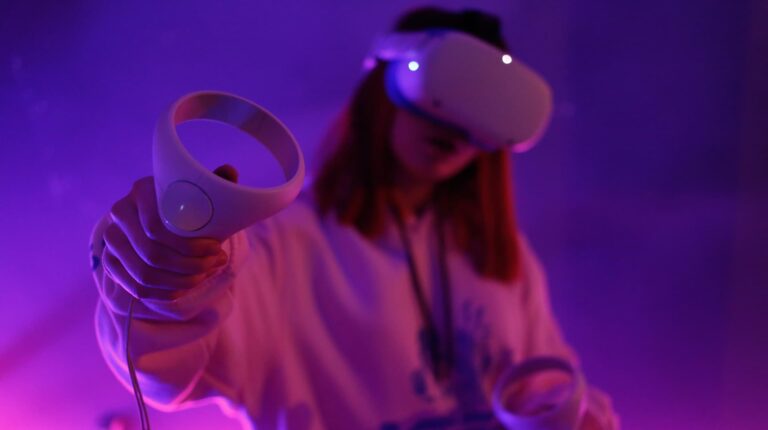
VR enthusiasts and proponents may recall Meta’s research findings last month that defined VR’s “Goldilocks zone.” Revisiting this research and diving deeper into strategic implications, what did Meta uncover, and what does it mean for VR companies and developers?
Backing up for those unfamiliar, Meta identified the “just right” session length for VR interaction to be between 20 and 40 minutes. This amount of time is long enough for players to feel fully satisfied and short enough to prevent fatigue and discomfort. The Goldilocks zone is also becoming the general recommendation for developers to design better VR experiences.
The Research Behind the Goldilocks Zone
So how did Meta come up with this finding? Conducting its own research, it found the best window of VR game session lengths by studying how players interact with their headsets over time. The company analyzed user behavior, comfort levels, and feedback to determine when a session starts to feel too short to be valuable and too long to become comfortable.
The research shows that sessions under 20 minutes often do not justify the setup time of putting on a headset and adjusting equipment. On the other hand, playing beyond 40 minutes can lead to physical strain, motion sickness and reduced enjoyment. Factors like headset weight, display resolution, and battery life also influence how long people are willing to stay in VR.
This data provides a measurable guideline for game design content delivery. It also signals that optimizing experiences for comfort is just as important as creating compelling gameplay experiences.
What Does This Imply for Developers and Studios?
Knowing this optimal session length, developers can create VR experiences that players will want to return to by using this recommendation as a guide.
Game Pacing
Designing around the Goldilocks zone means structuring gameplay so sessions wrap up naturally within that time frame. This could mean building levels, missions or challenges that fit comfortably into 20-40 minutes. It avoids players feeling rushed or overstretched.
For example, Beat Saber infuses short, high-intensity songs that last a few minutes each into the gameplay. Players can string together as many tracks as they like to use them as part of their workout regimen or to gain a burst of energy for a work break. These sessions can be satisfying enough without pushing past users’ comfort levels while naturally fitting into Meta’s recommended length.
Studies have even shown that 20-minute sessions with Beat Saber improve cognitive performance. These shorter gameplay sessions ensure players get enough time to feel more focused and return to work feeling refreshed.
Content Updates
Shorter optimal sessions encourage studios to deliver new content in smaller, frequent updates instead of long, draining gameplay drops. This keeps users engaged over time without causing fatigue.
Ghosts of Tabor — a first-person shooter survival VR game — is updated consistently to keep the gameplay interesting without being too overwhelming. While it occasionally drops major updates, the developers add new storyline quests and objectives more often to offer the right engagement.
Hardware Optimization
A game’s length often must work within headset limitations like battery life, heat generation and comfort. Designing experiences that fit the Goldilocks zone can reduce technical interruptions and improve overall performance. Meta has even acknowledged that longer sessions can expose hardware pain points, which is why many newer titles are optimized for shorter, more focused gameplay.
Player Experience
Session length directly influences how much players enjoy and trust the experience. They are less likely to return if a game feels overwhelming or physically uncomfortable. And, as research shows nearly 59% of customers will stop using a product after several bad experiences, this could even affect users’ interest in using any VR whatsoever over time. However, sessions designed to end on a high note within the 20-40-minute time frame leave users satisfied enough to return without feeling VR sickness or neck strain.
Experience enhancements like this help with onboarding. New users are more likely to stick with VR if their first experience is comfortable and enjoyable, creating a positive first impression that supports long-term adoption.
Considerations for the Future of VR Hardware and Content
The Goldilocks zone research has implications for how VR hardware and content may evolve.
Ergonomics
If 20-40 minutes is the optimal play window, headsets need to remain comfortable for the entire session. This means lighter designs, better weight distribution, improved padding and optimal ventilation. Manufacturers that address these pain points could make longer sessions more appealing without risking physical discomfort.
Battery Life and Performance
Optimizing battery life for gameplay sessions ensures a smooth experience without mid-session interruptions. Hardware updates may also focus on reducing power consumption without sacrificing performance.
Development Costs and Return on Investment (ROI)
The cost of VR development remains a major consideration since projects can range from $1,000 for basic features to $50,000 or more for fully built platforms. Designing content that is just right may help manage scope, control costs and achieve faster returns. It may also encourage developers to produce multiple shorter experiences instead of one massive, expensive build.
Content Structure and Delivery
Rather than focusing on expansive, hours-long experiences, studios may deliver content in modular segments. This strategy aligns with player comfort and engagement and also creates opportunities for ongoing monetization through downloadable content (DLC) and subscription models.
Setting a New Standard for VR Play
VR design and gameplay are improving now that Meta has found the Goldilocks zone for developers and hardware makers to use as a practical benchmark. It gives companies an understanding of how to balance immersion with comfort and changes they can make to deliver better content to VR users. The industry can create more fitting experiences for all by designing games that are just right.
 Eleanor Hecks is Editor-in-Chief of Designerly Magazine where she specializes in design, development, and UX topics. Follow Designerly on X @Designerlymag.
Eleanor Hecks is Editor-in-Chief of Designerly Magazine where she specializes in design, development, and UX topics. Follow Designerly on X @Designerlymag.

